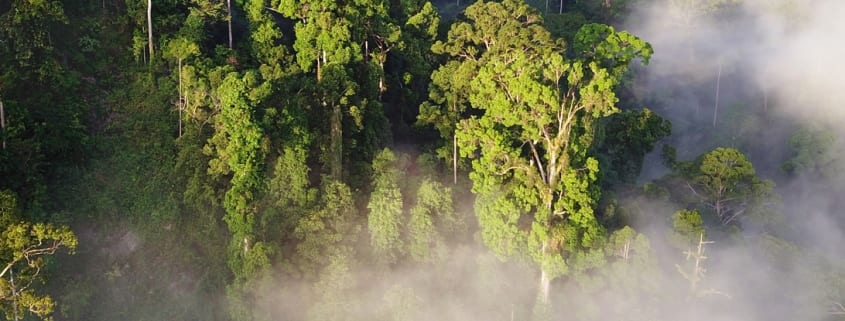Climate Change Series Part 2 – Rainforest Destruction is a Major Contributor to Global CO2 Emissions
Our first story in Rainforest Trust’s climate change series focused on how tropical forests naturally sequester carbon dioxide, thereby helping to regulate a significant component of global climate change: the greenhouse gases in our atmosphere. However, when a tropical forest is damaged or destroyed by, e.g. logging or burning, the carbon stored in the soils and plants’ above-ground mass is released back into the atmosphere, actually significantly contributing to our growing CO2 emissions problem.
Unfortunately, our global tropical forest coverage is drastically being reduced each year. Originally, six million square miles (3.84 billion acres) of tropical rainforests existed worldwide. Now, there are only 2.4 million square miles (1.536 billion acres). And, although tropical deforestation rates slowed in the 2000s compared to the rates in the 1990s, estimates show they are once again increasing this decade. According to the United Nations Food and Agriculture Organization (FAO), current tropical deforestation is occurring at a rate that is some 8.5 percent greater than it was in the 1990s. This equates to nearly 70,000 acres of rainforest lost every single day.
Deforestation and degradation of all the world’s forests release immense quantities of carbon dioxide into the atmosphere, second only to the burning of fossil fuels. Tropical deforestation alone accounts for approximately 15 percent of net global carbon emissions. This amounts to about the same carbon emissions as the entire global transportation sector (e.g. cars, trucks, ships, etc.), according to the Intergovernmental Panel on Climate Change’s (IPCC) Climate Change 2014: Mitigation of Climate Change report.
By preventing deforestation through the creation of protected areas, Rainforest Trust prevents carbon emissions and safeguards the planet’s resilience to climate change. In all the projects Rainforest Trust has begun working on just since May 2016, initial estimates of above-ground carbon storage come to 669,371,577 metric tons. If released to the atmosphere, that would be equivalent to the carbon emissions of more than 142 million cars per year.
Therefore, halting deforestation and degradation can be an integral part of climate change mitigation.
“Tropical forest conservation and restoration could constitute half of the global warming solution, according to a recent peer reviewed commentary in Nature Climate Change,” Rainforest Trust CEO Dr. Paul Salaman stated in his Guardian Editorial.
“Deforestation in the name of economic development has occurred routinely over many decades without regard to its devastating consequences. It is completely unsustainable for governments to continue to provide concessions, subsidies and tax breaks to business when logging, mining, fires, palm oil plantations, large scale commercial agriculture, cattle ranching and road construction continue to diminish the earth’s finite, invaluable rainforests,” Dr. Salaman said.
The bottom line is that when a forest is destroyed not only do we lose the potential to have carbon pulled out of the atmosphere for decades to come, but we also have once-stored carbon dioxide released back into the atmosphere. It is the proverbial loss-loss situation when it comes to mitigating climate change, among other important environmental protections.
The good news is that we are becoming more aware of the importance of protecting rainforests, resulting in more areas under protection today than ever before, thanks to efforts like ones carried out by Rainforest Trust and its partners. To date, we have purchased and protected more than 17 million acres, with plans to more than double that amount to 50 million acres by 2020 through the SAVES Challenge.
“The case for rainforest preservation – already overwhelmingly strong – can no longer be cast as a niche effort of conservationists and scientists; it needs to be everyone’s concern. For those wishing to tackle our planet’s greatest environmental challenge, there is no better place to begin than saving our tropical rainforests,” Dr. Salaman concluded.




